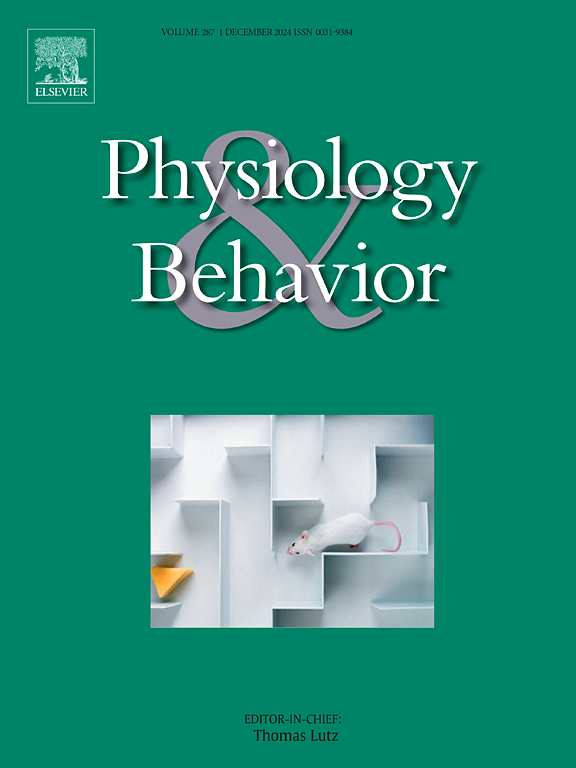在囊性纤维化儿童的3年随访中,父母报告的饮食缓慢测量与体重状况有关。
IF 2.5
3区 医学
Q2 BEHAVIORAL SCIENCES
引用次数: 0
摘要
目的:饮食行为是改善CF患者代谢健康等预后的潜在目标。使用儿童饮食行为问卷(CEBQ)(一种简短的家长报告工具)中的进食缓慢亚量表,测试进食缓慢是否与CF儿童3年随访中的体重状况有关。方法:60例患者(平均年龄7.7±3.2岁,男性66.7%)的家长在研究开始时的常规门诊时间内完成CEBQ,包括评估进食缓慢的4项分量表(CEBQ- se)。身体质量指数z分数(BMIz)使用基线和1年、2年和3年随访时收集的人体测量数据计算,用于线性混合模型(LMM)。结果:采用儿童CEBQ-SE评分制作3个CEBQ-SE分题。根据模型估计,在所有时间点,低CEBQ-SE的实验组(吃得最快的实验组)比中等CEBQ-SE实验组(基线:-0.09,1年:-0.06,2年:-0.03,3年:-0.02)和高CEBQ-SE实验组(基线:-0.05,1年:0.08,2年:0.10,3年:0.01)的BMIz(基线:0.46,1年:0.58,2年:0.64,3年:0.67)都要高。敏感性分析要么忽略了曾经使用胃管的儿童,要么没有使用过食欲刺激药物的儿童,证明了这些干预措施在促进达到体重状态目标方面的效用,特别是对于低体重指数和进食缓慢的儿童。结论:基线进食慢度低与CF儿童1、2和3年后的高bmi有关。CEBQ-SE亚量表可以识别出可以从早期干预中受益的儿童,以优化体重状况和饮食行为。本文章由计算机程序翻译,如有差异,请以英文原文为准。
Brief parent-report measure of slowness in eating is associated with weight status in children with cystic fibrosis over a 3-year follow-up
Objective
Eating behaviors are potential targets to improve outcomes including metabolic health in those with CF. We aimed to test whether slowness in eating was associated with weight status over 3 year follow-up in children with CF, using the slowness in eating subscale from the Child Eating Behavior Questionnaire (CEBQ), a brief parent-report instrument.
Methods
Parents of 60 patients (mean age 7.7±3.2; 66.7% male) completed the CEBQ, including the 4-item subscale assessing slowness in eating (CEBQ-SE), during regular clinic hours, at study entry. Body Mass Index z-scores (BMIz) were calculated using anthropometric data collected at baseline and at 1, 2, and 3 year follow-up for use in Linear Mixed Models (LMM).
Results
Children’s CEBQ-SE scores were used to create 3 CEBQ-SE tertiles. Based on model estimates, at all time-points, the low CEBQ-SE tertile (fastest eaters) had a greater BMIz (Baseline: 0.46, Yr 1: 0.58; Yr 2: 0.64; Yr 3: 0.67) than both the medium CEBQ-SE tertile (Baseline: -0.09, Yr 1: -0.06, Yr 2: -0.03, Yr 3: -0.02) and high CEBQ-SE tertile (Baseline: -0.05, Yr 1: 0.08, Yr 2: 0.10, Yr 3: 0.01). Sensitivity analyses either omitting children who had ever used a gastric tube, or children who had never been on appetite-stimulating medication, demonstrated the utility of these interventions to promote reaching weight status goals, particularly for children with low BMIz and slow eating.
Conclusion
Low slowness in eating at baseline was associated with high BMIz 1, 2, and 3 years later in children with CF. The CEBQ-SE subscale could identify children who could benefit from early intervention to optimize weight status and eating behavior.
求助全文
通过发布文献求助,成功后即可免费获取论文全文。
去求助
来源期刊

Physiology & Behavior
医学-行为科学
CiteScore
5.70
自引率
3.40%
发文量
274
审稿时长
47 days
期刊介绍:
Physiology & Behavior is aimed at the causal physiological mechanisms of behavior and its modulation by environmental factors. The journal invites original reports in the broad area of behavioral and cognitive neuroscience, in which at least one variable is physiological and the primary emphasis and theoretical context are behavioral. The range of subjects includes behavioral neuroendocrinology, psychoneuroimmunology, learning and memory, ingestion, social behavior, and studies related to the mechanisms of psychopathology. Contemporary reviews and theoretical articles are welcomed and the Editors invite such proposals from interested authors.
 求助内容:
求助内容: 应助结果提醒方式:
应助结果提醒方式:


